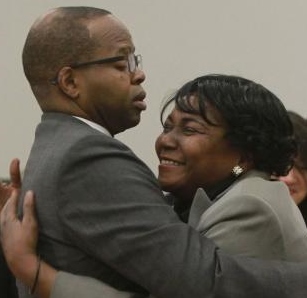 Vanessa Gathers hugs Brooklyn DA Ken Thompson (photo by Jesse Ward for New York Daily News) On November 18, 1991, 71-year-old Michael Shaw’s two daughters found him in his apartment in the Crown Heights neighborhood of Brooklyn, New York. He had been badly beaten. He said he had been robbed and attacked by three women the night before.
Shaw was taken to a hospital where he became comatose. He died in April 1992. At that time, the case was elevated from robbery and assault to homicide and was assigned to New York police detective Louis Scarcella.
Soon after Shaw died, Scarcella crossed paths with 34-year-old Vanessa Gathers, a neighborhood resident, who told Scarcella that a woman in the neighborhood had admitted being involved in the assault. Scarcella interviewed the woman and she denied involvement, but implicated three others in the crime. The case went dormant.
Five years later, after Scarcella had been transferred out of the Brooklyn homicide bureau and into the 77th Precinct to solve “cold cases,” the first case he turned to was the Shaw murder.
Scarcella found Gathers living in the same building where she lived in 1991 and brought her in for questioning. He said he had a witness who placed her in Shaw’s apartment when he was beaten and robbed and forensic evidence linking her to the crime. He promised that she would be released if she would just admit she was present at the time of the crime. Gathers took a polygraph examination and Scarcella said she failed. When Gathers finally relented and gave a video-taped confession, Scarcella didn’t let her go and instead arrested her for manslaughter, burglary and robbery. Gathers recanted the confession almost immediately, but it was too late.
Gathers went to trial in Kings County Supreme Court in February 1998. The primary evidence against her was the confession, which Scarcella read in court and testified that he obtained without coercing Gathers. In the confession, Gathers said she went to Shaw’s apartment with another woman who beat Shaw, who was in a wheelchair. Gathers said she took $60 from Shaw’s pocket. Gathers testified in her own defense and denied any involvement and told the jury the confession was false.
On February 25, 1998, the jury convicted Gathers of second-degree manslaughter, first-degree robbery and second-degree burglary. She was sentenced to five to 15 years in prison. No one else was ever charged in the case.
In 2001, Gathers’ appeal was denied. In March 2007, she was released from prison on parole, still maintaining her innocence.
In 2011, Kings County District Attorney Charles Hynes created a Conviction Integrity Unit and invited defense attorneys to present cases in which innocent defendants may have been convicted. One case the unit learned about was that of David Ranta, who was convicted of murder based on an investigation by Detective Scarcella, who had retired in 1999. The Conviction Integrity Unit’s investigation found that one witness had been told to pick Ranta in a lineup, and that two prosecution witnesses—both convicted felons—were allowed to leave jail, smoke crack and have sex with prostitutes in return for implicating Ranta.
In March 2013, Ranta’s conviction was vacated, the charge was dismissed and he was released from prison.
A few months later, The New York Times published an article accusing Scarcella of misconduct in many investigations: fabricating evidence, coercing witnesses and concealing evidence of defendants’ innocence. The report, along with a growing chorus of other news media, imprisoned defendants and defense lawyers, prompted the Kings County Conviction Integrity Unit to begin to re-investigate 57 cases in which Scarcella was involved and more than 30 other murder cases in Brooklyn.
In 2014, after Ken Thompson defeated Hynes to become the Brooklyn District Attorney, he reorganized the unit and rechristened it the Conviction Review Unit. The number of cases involving Scarcella expanded to about 100, most of them homicides.
In 2015, attorneys for The Legal Aid Society and the law firm of Hughes Hubbard & Reed, who had been representing Gathers since 2013, asked the Conviction Review Unit to investigate the case.
The Conviction Review Unit discovered that Shaw was never in a wheelchair and it was highly unlikely he would have had any money for anyone to steal—as Gathers’ said in the confession. There was a witness who said Gathers was involved, but she had been deemed not credible from the very beginning. There was no forensic evidence linking her to the crime. Although the polygraph examination indicated deception on Gathers' part, the Conviction Review Unit concluded that the combination of the general unreliability of polygraph results and the fact that the examination was five years after the crime rendered it of no evidentiary value.
On February 23, 2016, Thompson filed a motion to vacate Gathers’ convictions. The motion was granted and Thompson dismissed the charges.
In May 2016, Gathers filed a claim for compensation in the New York Court of Claims. It was settled for $1.5 million. She separately received $2.4 million in a settlement with the City of New York.
In July 2018, Shawn Williams became the 14th exoneration connected to Scarcella.
– Maurice Possley
|